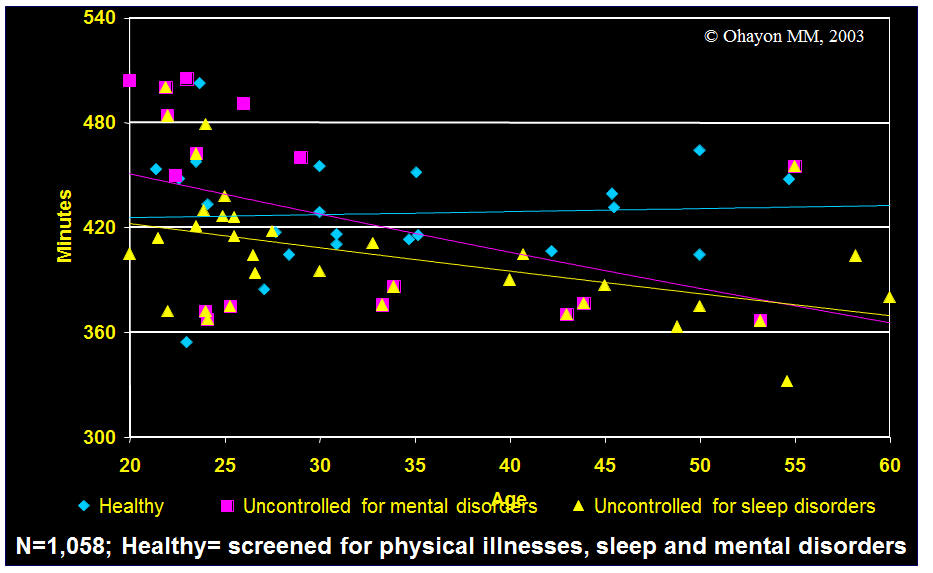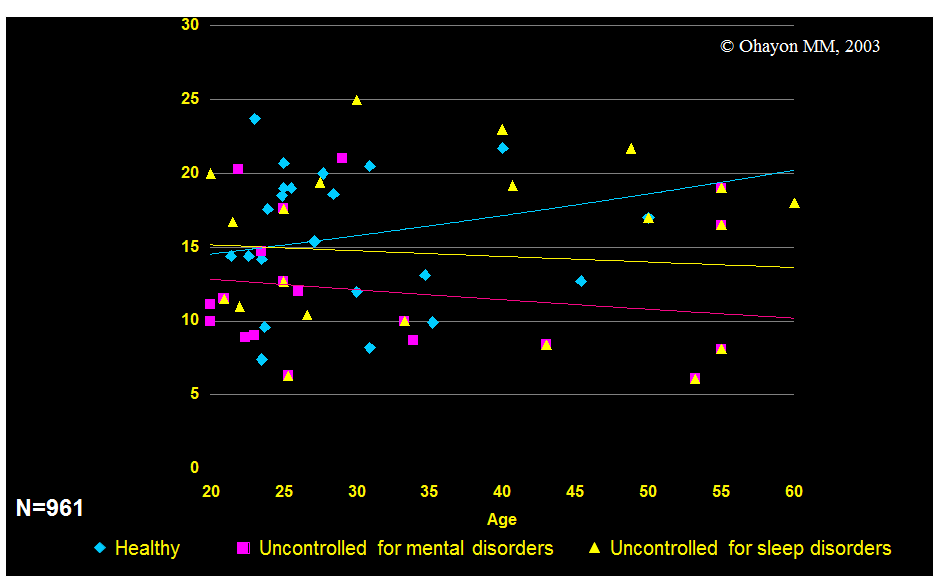Evolution of the Objective Sleep Parameters in Healthy Adult Population
First created | 01/12/1999
Last edited |
Sleep patterns evolve across the normal aging process in complex ways. Changes in sleep patterns across childhood and adolescence, for example, are not only related to chronological age but also to maturational stage.
Few studies, however, have made comprehensive analyses of these two aspects in adolescents (1). Similarly, chronological age in elderly people does not always match physiological age. Therefore, changes in sleep patterns may happen earlier, i.e., at a younger age, for some individuals or at an older age for others. Further, epidemiological and other studies suggest that much of the sleep disturbance typically seen in old age is likely the result of medical co-morbidities than age per se (2-6).
Nevertheless, four age-related changes have been consistently demonstrated in polysomnographic (PSG) studies of sleep architecture: total sleep time (7-29), sleep efficiency (7,9-14,17-23,25-29,30-36), and slow wave sleep (7,8,10, 12-18, 21-28, 31,33, 35,37-39) all decrease, while wake after sleep onset (12-14,16,17,19,21,23,28,29, 32,33,36,37,40) increases with age.
However, a number of PSG sleep characteristics remain uncertain as regard their evolution with age:
(a) sleep latency has been reported to increase with age in some studies (10,13,26,31,40), while several other studies found no significant changes with age (8,9,12, 14,16,17,20-23,28,29,32,33,35-37,39,41). Likewise, a number of studies found no significant differences with age for (b) percentage of stage 1 (9,25,26,35,39,42) and
(c) stage 2 (9,13,20,22,23,25,33,35,36,42,43) while many others reported an increase with age of these stages (7,8,12,17,27,28,31).
(d) Similarly, REM sleep has reported to decrease with age in several studies (7,8,10-12,14,16-18,20,21,23-26,28,31,33,37,38,44) while many other studies found no such association with age (9,13,15,19,22,27,34-36,39-43).
Why such discrepancies between the studies?
Several factors may be responsible for the difficulties identifying age trends in sleep architecture of apparently healthy subjects, for example: small sample sizes; inconsistency in controlling factors that may influence sleep, such as mental or physical illness; uncontrolled use of alcohol, drugs or medications; or insufficient screening for sleep disorders.
METHODS
TARGETED STUDIES
- Non-clinical studies
- "Healthy" participants aged 18 to 60 years
- Included measures of sleep characteristics by "all night" polysomography (PSG)
- Included data presented numerically.
- Published between 1960 and 2003 in peer-reviewed journals
VARIABLES ANALYZED
- Sleep latency (SL)
- Sleep efficiency (SE)
- Total sleep time (TST)
- Stage 1, stage 2, slow wave sleep (SWS), REM
N of studies: 39
N of subjects: 1,450
Age range: 18-60 years
Data examined: TST, SL, SE, REM, S1, S2, SWS
"Healthy" participants screened for
- Physical illnesses (31 studies)
- Sleep apnea (14 studies),
- Sleep disorders (26 studies)
- Mental disorders (27 studies)
- Drug/alcohol use (25 studies)
TOTAL SLEEP TIME

n studies that screened for physical illnesses, sleep and mental disorders, total sleep time did not change with age.
Studies without screening for sleep disorders (d= -0.47) or without screening for mental disorders
(d= -0.24) had significant decrease in TST.
SLEEP LATENCY

Sleep latency increases of only about 5 minutes between 20 and 60 years
Inclusion of subjects with sleep or mental disorders had little effect on the effect size; i.e. it does not have an important effect on the association sleep latency and age
SLEEP EFFICIENCY

In studies that screened for physical illnesses, sleep and mental disorders, sleep efficiency remained unchanged from 20 to 60 years
Studies without screening for sleep disorders (d= -0.35) or without screening for mental disorders
(d= -0.34) had significant decrease in sleep efficiency
PERCENTAGE OF STAGE 1

In studies that screened for physical illnesses, sleep and mental disorders, percentage of stage 1 sleep significantly increased with age (d=0.48)
Inclusion of subjects with sleep (d=0.23) or mental (d=0.30) disorders decreased this association
PERCENTAGE OF STAGE 2

In studies that screened for physical illnesses, sleep and mental disorders, percentage of stage 2 sleep significantly increased with age (d=0.44)
Inclusion of subjects with sleep (d=0.11) or mental (d=0.15) disorders removed this association
PERCENTAGE SLOW WAVE SLEEP (SWS)

In studies that screened for physical illnesses, sleep and mental disorders, percentage SWS significantly decreased with age (d=-0.97)
Inclusion of subjects with sleep (d=-0.55) or mental (d=-0.67) disorders reduced this association
PERCENTAGE OF REM SLEEP

In studies that screened for physical illnesses, sleep and mental disorders, percentage of REM sleep significantly decreased with age (d=-0.58).
Inclusion of subjects with sleep (d=-0.22) or mental (d=-0.36) disorders reduced this association
CONCLUSION
In healthy adult individuals:
- Total sleep time, sleep latency and sleep efficiency have little variation with age
- Percentage of Stages 1 and 2 increase with age
- SWS and REM decrease
Studies that aim to document normal sleep data must carefully exclude participants with physical illnesses, drugs or alcohol use, sleep and mental disorders
Studies failing to meet this prerequisite should not be used as reference for normal sleep parameters
Ohayon MM, Carskadon MA, Guilleminault C, Vitiello MV. Meta-analysis of quantitative sleep parameters from childhood to old age in healthy individuals: developing normative sleep values across the human lifespan. Sleep. 2004 Nov 1;27(7):1255-73. Free PMC
